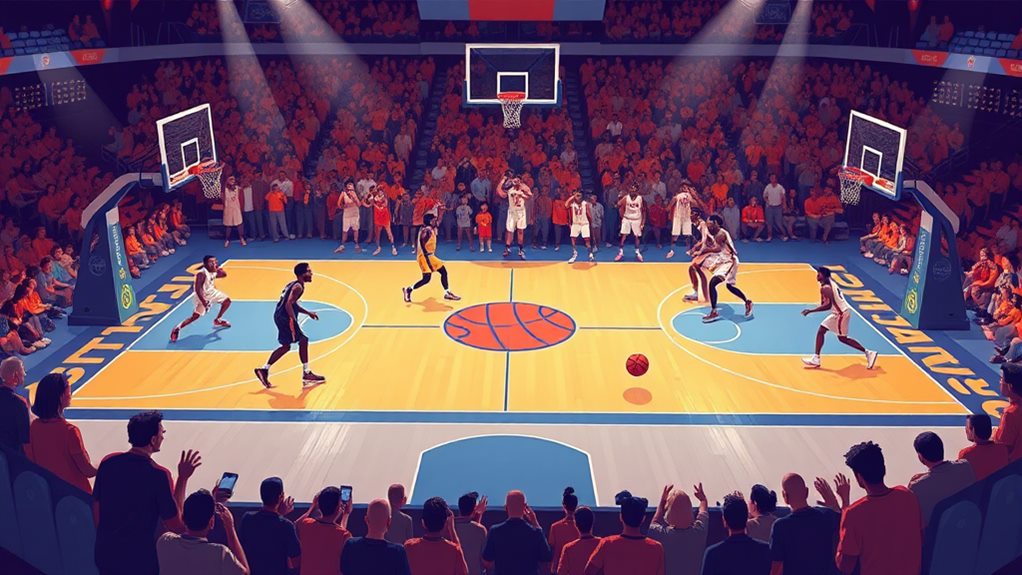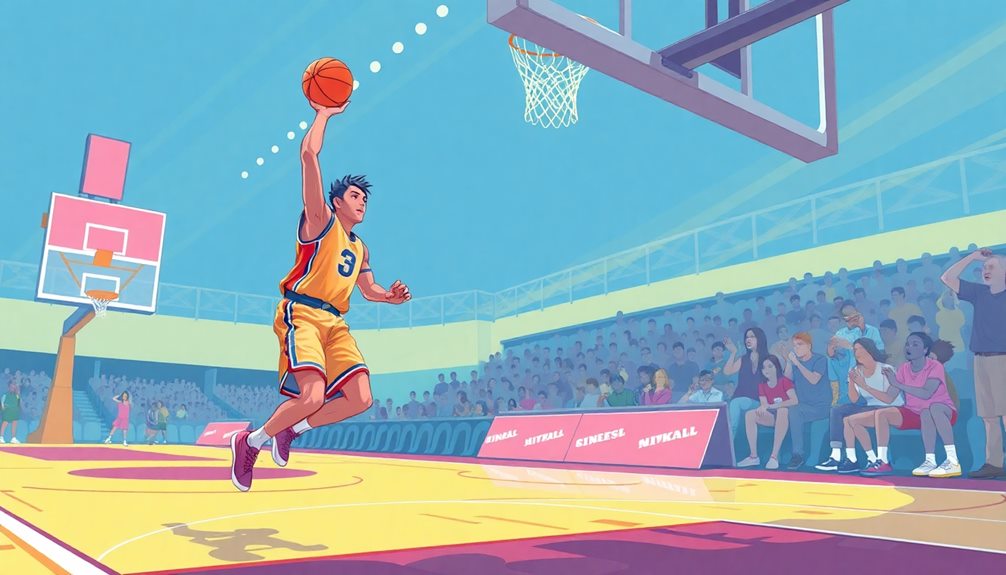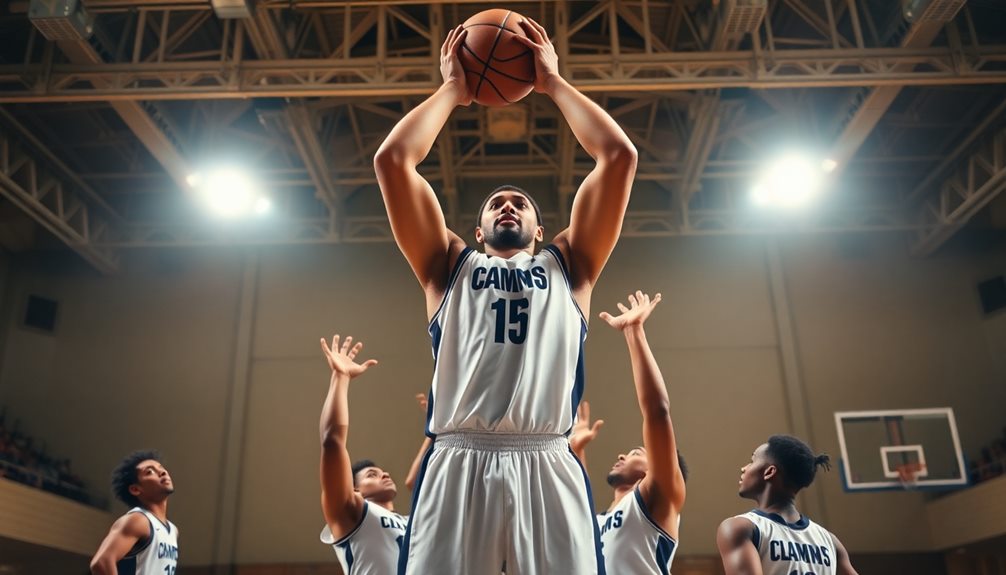
Basketball Positions: A Comprehensive Guide to Every Role
December 9, 2024Understanding basketball positions is key to appreciating the game's strategies. You've got five main roles: the Point Guard (PG) manages the offense, while the Shooting Guard (SG) focuses on scoring. The Small Forward (SF) offers versatility, and the Power Forward (PF) excels near the basket. Finally, the Center (C) dominates in rebounding and shot-blocking. Each position comes with unique responsibilities that influence team dynamics and effectiveness. Knowing these roles not only enhances your gameplay but also boosts communication on the court. Stick around to explore each position in depth and see how they can elevate your understanding of basketball.
Overview of Basketball Positions
Basketball features five primary positions that each play an essential role in the game's dynamics. Understanding these basketball positions explained can elevate your appreciation of the game and your team's strategy.
The Point Guard (PG) is often called the "floor general" and orchestrates the offense, ensuring plays run smoothly. Meanwhile, the Shooting Guard (SG) focuses heavily on scoring, especially from long-range shots, making them critical for offensive firepower. In modern basketball, the evolution of the center position reflects a trend towards versatility, with centers now expected to contribute to both scoring and ball movement.
Next, you have the Small Forward (SF), known for their versatility. This player balances scoring, rebounding, and defense while often tasked with guarding the opponent's best player.
The Power Forward (PF) typically plays close to the basket, specializing in rebounding and scoring in the paint, making them essential for controlling the game's physical aspects.
Finally, the Center (C), usually the tallest player, excels at shot-blocking and securing rebounds, anchoring the defense.
Each position's unique roles and responsibilities greatly impact gameplay dynamics. By grasping the importance of these roles, you'll better understand how a successful basketball team operates, maximizing each player's strengths for overall success.
Point Guard Responsibilities
At the heart of a basketball team's strategy is the Point Guard (PG), who takes on the role of the "floor general." This player orchestrates the offense, making split-second decisions that can change the course of a game.
As the primary ball-handler, you'll rely heavily on your ball-handling skills to bring the ball up the court and set up plays effectively. Additionally, understanding the dynamics of various positions can enhance your overall gameplay, especially when considering soccer moves guide for cross-sport inspiration.
Your main responsibility is to lead the team in assists, creating scoring opportunities for your teammates through precise passing. You'll need to possess a high basketball IQ, allowing you to read defenses and manage the game's tempo. By understanding your opponent's strategies, you can exploit weaknesses and make critical plays.
In addition to your offensive duties, the point guard also has an essential defensive role. You'll often be tasked with guarding the opposing team's primary ball-handler, seeking to create turnovers and disrupt their flow.
Balancing these responsibilities requires quick thinking and adaptability, as your decisions can greatly impact the team's performance. Embrace your role as the floor general, and lead your team with confidence!
Shooting Guard Characteristics

As a shooting guard, you'll need to excel in scoring and shooting skills, especially from long range. Your ability to create your own shot and drive to the basket is vital for your team's offensive success.
Utilizing speed can enhance your ability to outmaneuver defenders and create high percentage shots, which are essential in tight games.
On defense, you'll face the challenge of guarding perimeter threats, requiring quickness and agility to contest shots effectively.
Additionally, understanding event rules can help you exploit scoring opportunities while maintaining fair play.
Scoring and Shooting Skills
When it comes to scoring, shooting guards are often the key players on the court. They're typically your best long-range shooters, excelling in three-point shooting, with many averaging over 40% from beyond the arc. Their ability to stretch the floor is essential, as they occupy perimeter defenders, creating driving lanes for teammates.
Shooting guards often need to create their own shot, using their dribbling skills to navigate through defenses and find scoring opportunities. This skill allows them to be versatile scorers, as they don't just rely on the three-point shot; many also excel in mid-range shooting, making them threats at various distances.
Moreover, their quickness and agility are imperative, not just for offense but also for keeping pace with agile opponents. While their primary role revolves around scoring, they also contribute to the team by guarding perimeter threats, ensuring they can adapt to different game situations.
This combination of skills makes shooting guards critical for any team's offensive strategy, giving them the ability to change the course of a game with their scoring prowess.
Defensive Responsibilities and Techniques
In essential moments of the game, shooting guards take on the important role of defending the opposing team's top perimeter scorer. To excel in this position, you need agility and quickness to match their movements. Your defensive responsibilities include both on-ball and off-ball techniques, which are critical for shutting down high-scoring threats.
When guarding the ball handler, stay low in an athletic stance. Use your lateral quickness to slide with the offensive player, applying pressure to force difficult shots or create turnovers. Don't forget to keep a hand up to contest their shots effectively.
For off-ball defensive responsibilities, you must be vigilant. Anticipating passes and maneuvering around screens will help you stay one step ahead. A high basketball IQ is essential here; read the offensive plays and adjust your positioning accordingly.
Provide help defense when necessary to support your teammates, ensuring you're always in the right place at the right time.
Forward Positions Explained
Forwards play an essential role in basketball, blending size, speed, and skill to impact both offense and defense. The two main forward positions are Small Forwards (SF) and Power Forwards (PF), each with distinct responsibilities.
Small Forwards are often considered versatile players, capable of scoring from long-range, driving to the basket, and excelling in changeover offense. Their ability to adapt allows them to guard multiple positions, making their defensive skills crucial. Players like Cheryl Miller exemplify this versatility, as she redefined expectations for women's basketball players through her dynamic playstyle.
On the other hand, Power Forwards typically focus on scoring near the basket and rebounding. They combine strength and agility, effectively utilizing mid-range shooting to stretch the floor and create opportunities.
Both forward positions frequently engage in pick-and-roll situations, requiring them to work seamlessly with guards and centers.
When it comes to guarding opposing teams, forwards need to be on their toes, as they often face other forwards and centers. Notable examples include Kawhi Leonard, who showcases impressive defensive skills and scoring ability as a Small Forward, and Anthony Davis, known for his rebounding and scoring versatility as a Power Forward.
Mastering these roles enhances your overall game and contributes greatly to team success.
Center Position Role

The center position is essential to a basketball team's success, with players usually towering over their teammates, often standing 6'9" or taller. As the tallest player on the team, you play a key role in rebounding and shot-blocking, providing a powerful presence in both the offensive and defensive zones.
Your position shares similarities with the importance of a goalkeeper in soccer, where both roles are critical in protecting their respective areas and ensuring team success goalkeeping responsibilities.
You primarily score through close-range shots, using your post moves and securing offensive rebounds to contribute greatly to the team's scoring efforts.
Defensively, your responsibilities include protecting the paint from opposing players, contesting shots, and grabbing defensive rebounds, which are essential for launching fast breaks.
In pick-and-roll situations, you act as the screener, creating space for guards and forwards. Once the screen is set, you roll to the basket, looking for scoring opportunities.
Notable centers like Shaquille O'Neal and Kareem Abdul-Jabbar have showcased the impact of this position, dominating in scoring and rebounding while excelling defensively.
Importance of Understanding Positions
Understanding basketball positions is essential for enhancing team strategy, as it allows everyone to play their part effectively.
By recognizing how various positions contribute to a team's dynamics, players can better adapt their gameplay to fit diverse styles seen in international tournaments, showcasing the sport's evolution and global representation.
When you grasp your role, you can develop your skills more efficiently, boosting both individual and team performance.
Plus, this knowledge helps coaches make informed decisions that can elevate the entire squad's competitiveness.
Enhances Team Strategy
Grasping basketball positions is essential for enhancing team strategy. When you understand the distinct responsibilities of each position, you can help your coaches develop effective game strategies that capitalize on your strengths. This knowledge directly influences both offensive and defensive plays, ensuring your team operates cohesively during games.
Recognizing player roles allows for better allocation of minutes and matchups, which can greatly improve your chances of exploiting opponent weaknesses. By being familiar with positional dynamics, you can adapt your skills and play style, making your team more versatile and unpredictable on the court.
Moreover, when teams understand the importance of each position, they can enhance their training programs to focus on the specific skills required for success in each role. This targeted approach not only elevates individual performance but also boosts overall team performance.
Ultimately, the more you grasp basketball positions, the better equipped you'll be to contribute to a winning team strategy. Embracing these concepts will help you and your teammates excel, making each game an opportunity to showcase your collective strengths and tactical prowess.
Improves Player Development
Recognizing basketball positions not only enhances team strategy but also plays an essential role in player development. When you understand basketball positions, you can identify your strengths and weaknesses, leading to targeted skill development that improves your performance on the court. Each position comes with distinct responsibilities; for instance, point guards focus on playmaking while centers excel in rebounding. This knowledge allows you to concentrate your training on role-specific skills that align with your position.
Moreover, familiarity with positional dynamics enhances teamwork. As you learn to anticipate your teammates' movements and strategies, you'll foster better on-court communication. This synergy is important for a successful team.
Coaches can also benefit from your understanding of positions; they can design effective practice drills tailored to the unique skill sets required for each role, optimizing your player development.
Lastly, recognizing the significance of different positions helps aspiring players like you make informed decisions about your suitability based on your physical attributes and playing style. By aligning your development path with the right position, you'll maximize your potential and contribute meaningfully to your team.
Informs Coaching Decisions
Effective coaching hinges on knowing the distinct roles each player fills on the court. When you understand basketball positions, you can tailor your strategies to leverage each player's unique skills and responsibilities. This knowledge not only enhances overall team performance but also influences key coaching decisions.
Here are some ways understanding positions informs your coaching:
- Tailored Strategies: You can create game plans that maximize each player's strengths.
- Effective Development: Knowing roles helps allocate playing time wisely, ensuring players grow in their best positions.
- Tactical Analysis: Recognizing your opponents' positional capabilities leads to informed decisions during games.
- Smart Recruitment: Familiarity with positional requirements aids in identifying and developing players who fit your system.
- Clear Communication: Understanding roles fosters better communication and sets clear expectations, promoting a cohesive team environment.
Conclusion
So, you've mastered the basketball positions, huh? Congratulations! Now you can confidently explain to your friends why you're the best "waterboy" on the court. Just remember, while you're busy analyzing each role, the real MVP is still the guy who brings snacks to practice. Understanding positions is great, but if you can't find your way to the snack table, what's the point? After all, in the game of life, food is the only position that truly matters!


